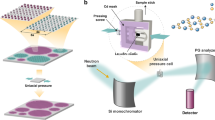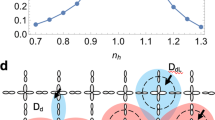Abstract
One of the most striking properties of the high-transition-temperature (high-Tc) superconductors is that they are all derived from insulating antiferromagnetic parent compounds. The intimate relationship between magnetism and superconductivity in these copper oxide materials has intrigued researchers from the outset1,2,3,4, because it does not exist in conventional superconductors. Evidence for this link comes from neutron-scattering experiments that show the unambiguous presence of short-range antiferromagnetic correlations (excitations) in the high-Tc superconductors. Even so, the role of such excitations in the pairing mechanism for superconductivity is still a subject of controversy5. For YBa2Cu3O6+x, where x controls the hole-doping level, the most prominent feature in the magnetic excitation spectrum is a sharp resonance (refs 6,7,8,9,10,11). Here we show that for underdoped YBa2Cu3O6.6, where x and Tc are below their optimal values, modest magnetic fields suppress the resonance significantly, much more so for fields approximately perpendicular to the CuO2 planes than for parallel fields. Our results indicate that the resonance measures pairing and phase coherence, suggesting that magnetism plays an important role in high-Tc superconductivity. The persistence of a field effect above Tc favours mechanisms in which the superconducting electron pairs are pre-formed in the normal state of underdoped copper oxide superconductors12,13,14, awaiting transition to the superconducting state.
This is a preview of subscription content, access via your institution
Access options
Subscribe to this journal
Receive 51 print issues and online access
$199.00 per year
only $3.90 per issue
Buy this article
- Purchase on Springer Link
- Instant access to full article PDF
Prices may be subject to local taxes which are calculated during checkout




Similar content being viewed by others
References
Anderson, P. W. The resonating valence bond state in La2CuO4. Science 235, 1196–1198 ( 1987).
Emery, V. J. Theory of high-Tc superconductivity in oxides. Phys. Rev. Lett. 58, 2794–2797 (1987).
Hirsch, J. E. Antiferromagnetism, localization, and pairing in a two-dimensional model for CuO2. Phys. Rev. Lett. 59, 228 –231 (1987).
Schulz, H. J. Superconductivity and antiferromagnetism in the two-dimensional Hubbard model: scaling theory. Europhys. Lett. 4, 609– 615 (1987).
Scalapino, D. J. The cuprate pairing mechanism. Science 284, 1282–1283 (1999).
Rossat-Mignod, J. et al. Neutron scattering study of the YBa2Cu3O 6+x system. Physica C 185–189, 86–92 (1991).
Mook, H. A., Yethiraj, M., Aeppli, G., Mason, T. E. & Armstrong, T. Polarized neutron determination of the magnetic excitations in YBa2Cu3O7. Phys. Rev. Lett. 70, 3490–3493 ( 1993).
Fong, H. F. et al. Phonon and magnetic neutron scattering at 41 meV in YBa 2Cu3O7. Phys. Rev. Lett. 75, 316–319 (1995).
Dai, P., Yethiraj, M., Mook, H. A., Lindemer, T. B. & Doǧan, F. Magnetic dynamics in underdoped YBa2Cu3O7-x: direct observations of a superconducting gap. Phys. Rev. Lett. 77, 5425–5428 (1996).
Fong, H. F., Keimer, B., Milius, D. L. & Aksay, I. A. Superconducting-induced anomalies in the spin excitation spectra of underdoped YBa2Cu3O6+x. Phys. Rev. Lett. 78, 713–716 ( 1997).
Dai, P. et al. The magnetic excitation spectrum and thermodynamics of high- Tc superconductors. Science 284, 1344–1347 (1999).
Uemura, Y. J. Bose-Einstein to BCS crossover picture for high-Tc cuprates. Physica C 282, 194–197 (1997).
Emery, V. J. & Kivelson, S. A. Importance of phase fluctuations in superconductors with small superfluid density. Nature 374, 434–437 (1995).
Lee, P. A. & Wen, X. G. Unusual superconducting state of underdoped cuprates. Phys. Rev. Lett. 78, 4111–4114 (1997).
Junod, A., Erb, A. & Renner, Ch. Specific heat of high temperature superconductors in high fields at Tc: from BCS to the Bose-Einstein condensation. Physica C 317, 333–344 (1999).
Junod, A. in Studies of High Temperature Superconductors Vol. 19 (ed. Narlikar, A. V.) 1 (Nova Science, New York, 1996 )
Janko, B. Thermodynamic constraints on the magnetic field dependence of the neutron resonance in cuprate superconductors. Preprint cond-mat/9912073 at 〈http://xxx.lanl.gov〉 (1999; cited 6 Dec. 1999).
Tranquada, J. M. et al. Neutron-diffraction determination of antiferromagnetic structure of Cu ions in YBa2Cu3O6+x with x = 0.0 and 0.15. Phys. Rev. Lett. 60, 156–159 (1988).
Bourges, P. et al. High magnetic field dependence of spin fluctuations in YBa 2Cu3O7. Physica B 234–236 , 830–831 (1997).
Dai, P., Mook, H. A. & Doǧan, F. Incommensurate magnetic fluctuations in YBa2Cu 3O6.6. Phys. Rev. Lett. 80, 1738—1741 (1998).
Mook, H. A. et al. Spin fluctuations in YBa2Cu3O6.6 . Nature 395, 580– 582 (1998).
Hayden, S. M. et al. Absolute measurements of the high-frequency magnetic dynamics in high-Tc superconductors. Physica B 241–243, 765–772 ( 1998).
Aeppli, G. et al. The weights of various features in the magnetic spectra of cuprates. Phys. Status Solidi B 215, 519 –522 (1999).
Arovas, D. P., Berlinsky, A. J., Kallin, C. & Zhang, S. C. Superconducting vortex with antiferromagnetic core. Phys. Rev. Lett. 79, 2871–2874 ( 1997).
Anderson, P. W. Two crucial experimental tests of the resonating valence bond-Luttinger liquid interlayer tunneling theory of high-Tc superconductivity. Phys. Rev. B 42, 2624– 2626 (1990).
Renner, Ch., Revaz, B., Genoud, J.-Y., Kadowaki, K. & Fischer, Ø. Pseudogap precursor of the superconducting gap in under- and overdoped Bi2Sr2CaCu2O 8+δ. Phys. Rev. Lett. 80, 149 –152 (1998).
Basov, D. N. et al. Sum rules and interlayer conductivity of high-T c cuprates. Science 283, 49– 52 (1999).
Yin, L., Chakravarty, S. & Anderson, P. W. The neutron peak in the interlayer tunneling model of high temperature superconductors. Phys. Rev. Lett. 78, 3559–3562 (1997).
Scalapino, D. J. & White, S. R. Superconducting condensation energy and an antiferromagnetic exchange-based pairing mechanism . Phys. Rev. B 58, 8222– 8224 (1998).
Demler, E. & Zhang, S. C. Quantitative test of a microscopic mechanism of high-temperature superconductivity. Nature 396, 733–735 (1998).
Chakravarty, S. & Kee, H.Y. Measuring condensate fraction in superconductors. Phys. Rev. B 61, 14821–14824 (2000).
Acknowledgements
We thank B. Janko, A. Junod, A. Kapitulnik, M. V. Klein, Ch. Renner and D. J. Scalapino for discussions. The work at ORNL was supported by the US DOE.
Author information
Authors and Affiliations
Corresponding author
Rights and permissions
About this article
Cite this article
Dai, P., Mook, H., Aeppli, G. et al. Resonance as a measure of pairing correlations in the high-Tc superconductor YBa2Cu3O6.6. Nature 406, 965–968 (2000). https://doi.org/10.1038/35023094
Received:
Accepted:
Issue Date:
DOI: https://doi.org/10.1038/35023094
This article is cited by
-
Investigation of optical and structural properties of tin-doped copper oxide thin films prepared by the drop-cast method
Journal of the Australian Ceramic Society (2022)
-
Adsorption, photodegradation, and selective removal of reactive red 2 dye onto cuprous oxide nanoparticles
Monatshefte für Chemie - Chemical Monthly (2022)
-
CuO supported 1-methyl-3-(3-(trimethoxysilyl) propyl) imidazolium chloride (MTMSP-Im/Cl) nanoparticles as an efficient simple heterogeneous catalysts for synthesis of β-azido alcohols
Journal of the Iranian Chemical Society (2019)
-
Optimizing the thermal annealing temperature: technological route for tuning the photo-detecting property of p-CuO thin films grown by chemical bath deposition method
Journal of Materials Science: Materials in Electronics (2018)
-
Pseudogap phenomena in ultracold atomic Fermi gases
Frontiers of Physics (2014)
Comments
By submitting a comment you agree to abide by our Terms and Community Guidelines. If you find something abusive or that does not comply with our terms or guidelines please flag it as inappropriate.



